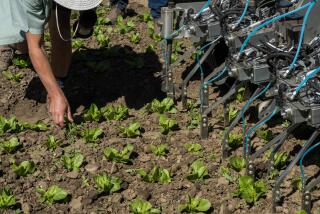‘Nanobionics’ aims to give plants superpowers
- Share via
Plants are an engineering marvel of nature. Fueled by sunlight, they recycle our carbon dioxide waste into fresh oxygen for us to breathe. Plus, they make the world prettier. But, with a little help from us humans, can they be coaxed to do even more?
Researchers at MIT have been experimenting with giving plants new powers by placing tiny carbon nanotubes in their chloroplasts — the tiny engine of the plant cell where photosynthesis takes place.
After much trial and error, their efforts have succeeded. Some of the altered plants produced in their lab have increased their photosynthetic activity by 30% compared with regular plants. Others were able to detect tiny traces of pollutants in the air.
And that’s just the beginning.
“The idea is to impart plants with functions that are nonnative to them,” said Michael Strano, a professor of chemical engineering who oversaw the experiments.
In other words, he wants to give plants superpowers.
Strano’s lab is the first to work at the nexus of plant biology and nanotechnology — a new field dubbed “nanobionics.”
Since no one had ever explored this area before, the team had to start at the very beginning. That meant figuring out how to get nanotubes into a plant in the first place.
In early experiments, they watered the plants with a solution containing nanoparticles, hoping the particles would be taken up through the roots. But that didn’t work. It turns out the structure of plant roots blocks nanotubes from entering the vascular system.
The team also tried cutting leaves and steeping them in the nanoparticle solution. That didn’t work either.
Undeterred, Strano’s team turned to the stomata, the small pores on the underside of leaves that let carbon dioxide in and oxygen and water out. The researchers found that if they shot the nanoparticle solution at high pressure from a syringe at the stomata, the nanotubes would get in.
The next challenge was to get the nanotubes to their intended destination — the tiny chloroplasts, 5 to 10 microns in length, floating inside the cells. To do this, the team invented a new system that wraps nanoparticles in a highly charged polymer. The polymer is especially attracted to the lipid bubble that surrounds each chloroplast. When the nanotubes hit the bubble, they slide right in.
“It is really impressive how well it worked,” said Juan Pablo Giraldo, a plant biologist who works in Strano’s lab. The nanotubes “go right in there and start assembling inside.”
After the delivery system was established, the researchers could play. They used chloroplasts in living plants as well as chloroplasts extracted from plant leaves — often spinach purchased at the supermarket.
Plants only use 10% of the sunlight available to them. All green light, for example, is reflected by the leaves. But after feeding the nanotubes to living plants, their photosynthetic activity increased by 30%. The technique worked even better on extracted chloroplasts (the kind they got from spinach), causing their photosynthetic activity to increase by 49%.
The MIT scientists aren’t sure exactly what the nanotubes did to make photosynthesis so much more efficient. One possible explanation they offered is that nanotubes share electrons with chloroplasts, allowing the chloroplast to capture a broader range of light (including green light).
Researchers in Strano’s lab had previously developed a carbon nanotube that responds to the presence of nitric oxide by drastically reducing its fluorescence. So the team prepared a solution of these nanotubes and shot it into the stomata.
As they had hoped, the plant leaves glowed less under an infrared light when exposed to nitric oxide. However, the signal was very subtle, so bushes that monitor air quality are still a long way off. Still, Strano and his colleagues think altered plants may one day be able to alert us to pollutants, pesticides or fungal diseases in the air around us.
And more experiments are on the way.
The MIT team is working on creating plants with even more exotic functions. For example, by using magnetic nanoparticles, it’s possible they could turn plants into communications antennae.
“The main vision we have is to use the unique features that plants have — the ability to rebuild themselves, capture solar energy to power themselves or capture carbon dioxide — to make devices that have similar properties,” said Giraldo, the lead author of a paper about the work published this month in the journal Nature Materials.
Alexander Star, a chemist at the University of Pittsburgh who was not involved with the study, said the research advances our understanding of how nanomaterials and living organisms interact. He noted that past studies have shown nanoparticles can be toxic to some ecosystems, but that did not seem to be a problem here.
Instead, he said, the researchers seemed able to optimize the performance of some of the plant’s machinery in a way that nature has not yet done.
“This work is an important step toward the rational design of plant systems capable of more efficient solar energy harvesting and bio-sensing — beyond the limits of natural evolution,” he said.
Twitter: @DeborahNetburn







